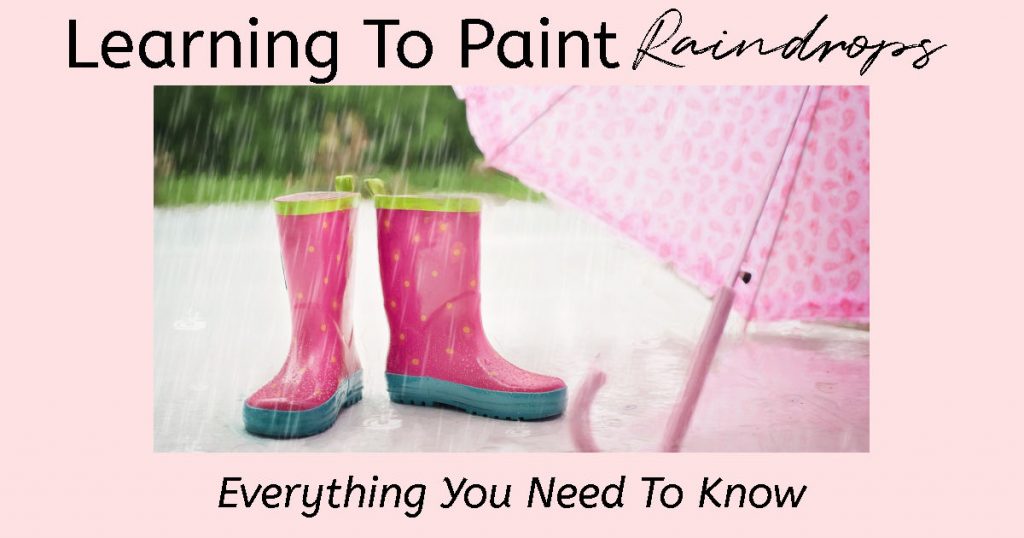In This Article...
- How to Paint the Rain with Acrylics for Beginners
- Why Knowing How To Paint a Raindrop is So Good!
- Paint a Better Water Droplet By Breaking Down The Anatomy
- Learn to Paint a Raindrop Close Up
- How to Paint a Rainy Day Window For Beginners
- How to Paint Dew Drops on a Flower
- Paint an Easy Rainy Landscape for Beginners
- Learn to Paint Tear Drops
- Summing Up How To Paint Rain
- Where In Your Home Would You Display a Rainy Painting?
How to Paint the Rain with Acrylics for Beginners
Is learning to paint raindrops something you’ve been wanting to try but have been hesitant because it looks too difficult? In this article, we’re going to dissect a raindrop so we can understand what makes a water droplet….well, a water droplet.
Knowing all of the parts that make up a raindrop makes it easier for you to see the different shades of paint you’ll need and where to place them.
We’ll also talk about the benefits of knowing how to paint rain, and I’ll give you my top video recommendations including what you’ll learn from each, and any tips I have for success. Let’s get started!
Why Knowing How To Paint a Raindrop is So Good!
Learning to paint water droplets is going to be so useful to you! With all of the highlights, shadows, and reflections you’ll get very comfortable with the whole process.
In the future, the connection between highlights and shadow and your light source will become easier to recognize and figure out.
Paint a Better Water Droplet By Breaking Down The Anatomy
A major part of learning to paint raindrops is knowing all of the parts that have to be painted a different shade.
A raindrop is basically a transparent orb. This is also true for dewdrops, teardrops, and basically any type of water droplet. So, get ready, you’ll be dealing with a lot of highlights and shadows.
Because raindrops are typically round and always reflective, you’ll have primary highlights and secondary highlights and the same goes for your shadows.

In the photo above you can see the raindrop has many different shades within it. The primary highlight is down near the base of the raindrop and near the flower petal.
The reflective, or secondary, highlight is across, and at an angle, from the primary highlight, right along the edge.
You’ll also notice that other little bits of light hit the water droplet. These are small reflections that you’d add if you feel like you need to bounce a bit more light around.
If you look closely at the primary highlight you’ll see that it isn’t right up against the edge of the raindrop. So, just remember, when painting water drops don’t put all of your highlights along the edge of the raindrop or you run the risk of it looking like you’ve created an outline.
Now, let’s talk about the shadows. Again, you’ll see that there is a primary shadow, a secondary shadow, and then there is another shaded section that’s quite large but diffused so it’s not as dark.
It’s also good to keep in mind, because raindrops are transparent, whatever is on the far side of the raindrop, according to the viewer’s perspective, is going to show through and be a slightly muted color compared to the rest of the background.
Also, if you look right underneath the back end of the raindrop, which is the part that’s further away from the light source, you’ll notice there’s a shadow that’s quite small but there’s also a highlight on the flower petal. That highlight is actually a reflection of the light that’s shining down through the dewdrop.
When you realize how many different parts there are to water droplets, you can understand why they can seem difficult.
However, all this comes down to is different shades of your background color, painting soft blended edges, and knowing what paint color goes where depending on the light source.
If you’d like a step-by-step process of how to add highlights and shadows to a round object, take a look at my article where I go over, step-by-step, how to make a circle look like a sphere.
Learn to Paint a Raindrop Close Up
If learning to paint raindrops is a new concept for you, I highly suggest you watch “10 Easy Steps for Painting Realistic Water Drops” by The Art Sherpa. If you’ve been around here for a while, you know I love her sense of humor and style of teaching!
This is a very short video tutorial that’s packed with useful information that Cinnamon will walk you through.
Materials List:
- Titanium White
- Mars black
- Golden glazing liquid
- A few flat or bright paintbrushes in different sizes
- A couple of Filbert paintbrushes (totally optional – I think she just used it because a Filbert has a nice rounded edge)
- Some detail round brushes
- An angle brush
- Clean water
- Paper towel or rag
- Chalk or watercolor pencil
- Canvas, paper, etc.
- A palette for your paint
Painting Skills You’ll Learn:
- Blending
- Painting a water droplet from an aerial perspective
- Where to place shadows and highlights
- What kind of pressure to use on your paintbrush when blending
- How to mix your colors so you have a nice gradient to paint all of those highlights and shadows
Extra Tips:
- I highly recommend you try this tutorial as is but then do it a couple more times using different colors so you can get a sense of how many different shades you’ll need to paint future water droplets
- If you don’t have golden glazing liquid you can also use the dry brushing technique to get those soft edges. Check out my article on different ways to blend with acrylic paint if you want to learn more about it
How to Paint a Rainy Day Window For Beginners
Next up, we have “Rainy Day Step by Step Acrylic Painting on Canvas for Beginners” by Painting with Jane.
Okay, this is a long video but it’s perfect for learning to paint raindrops because you paint tons of raindrops on a window. You’ll get so much practice that you will be a raindrop genius by the time you’re through!
Materials List:
- Canvas, paper, etc.
- A large flat brush
- Another large brush that’s really soft
- An angle brush (or whatever brush you’re comfortable using to make straight lines)
- A small detail brush
- A palette knife
- Mars black
- Titanium White
- Transparent Mixing White or Zinc White (if you have it)
- Chalk
- Clean water
- Paper towel or rag
- A palette for your paint
Skills You’ll Learn:
- Mixing paint with a palette knife (also known as squishing paint, which we love around here)
- How to create a blurred background using a palette knife
- How the direction that you swipe your palette knife will create different effects
- How to create a foggy effect using transparent white paint
- How to paint really tiny raindrops
- How to paint really easy shadows and highlights on the raindrops
- How to draw a straight line with an angled paintbrush
- Adding highlights to the window frame
- How to paint water streaks down the window
Extra Tips:
- Start by using a smaller canvas because it’s going to take you some time to paint all of the raindrops
- Make sure to dry your canvas thoroughly after using a palette knife because the paint is going to be thicker than you might be used to
- If you don’t feel comfortable painting the straight lines for the window panes just don’t bother adding them
- If you wanted to play with more color in this tutorial you could use very soft muted colors, like grey green for the trees, for your backgrounds and add pale yellow highlights on all of your raindrops to represent the sun coming out after the rain
How to Paint Dew Drops on a Flower
I chose Michelle the Painter’s video tutorial “Learn How to Paint Flower Droplets with Acrylic ” for beginners who are interested in learning to paint raindrops because the tutorial focuses on the dew drops while the background and the flower are very impressionistic, using very loose brush strokes.
Materials List:
- Canvas, paper, etc.
- Large flat bristle brush
- Small round synthetic paintbrush
- Titanium White
- Burnt Umber
- Deep Yellow or Yellow Oxide
- Fire Red or Cadmium Red Medium
- Purple Violet or Dioxazine Purple
- Clean water
- Rag or paper towel
- A palette for your paint
Painting Techniques You’ll Learn:
- How to make a soft out-of-focus background
- How to paint an impressionistic flower
- How to create a smooth blend between colors to suggest light and shadow
- Painting a dewdrop from a side view perspective
- Adding shadows and highlights to a more whimsical dewdrop
Extra Tips:
- Michelle adds the reflection of some daisies to each dewdrop but you could totally leave that part out to make the raindrop look a bit more realistic
- Feel free to use different colors for your background and your flower but make sure that they’re colors that work well together (check out my article all about color to learn what colors work well together, which ones will create the most !kapow!, and how to use colors without accidentally creating mud)
- If you do decide to change the background colors don’t forget to use them in the reflections on your dewdrops
Paint an Easy Rainy Landscape for Beginners
A quick and simple tutorial to try when you’re learning to paint raindrops is “How to Paint a Rainy Forest” by AhmadArt. This step-by-step video is fantastic for beginners because it uses minimal paint colors and paintbrushes.
Materials list:
- Titanium White
- Turquoise (green and blue mixed together with a bit of white)
- Prussian Blue or Ultramarine Blue and a tiny bit of black
- Canvas, paper, etc.
- A palette knife or a large flat brush
- Several pieces of a kitchen sponge
- A small detail round brush
- A rake paintbrush or a very fuzzed out old paintbrush that’s seen better days
- Clean water
- Paper towel or rag
- A palette for mixing paint
Skills You’ll Be Practicing:
- How to blend acrylic paint using a kitchen sponge
- How to create the illusion of distant trees using a kitchen sponge
- How to create a foggy look
- How to paint trees
- How to create depth through the placement of the trees
- How to paint a rainy sky
Extra Tips:
- I have an article all about the different brushes you can use to paint forest trees and instructions on how to paint them if you need extra help
- Instead of putting the paint right on the canvas and spreading it out with a palette knife, you can use a flat brush and just paint it like usual but make sure that you use lots of paint because the next step will be using a kitchen sponge which will soak up some of the paint
- Feel free to use your favorite colors but do follow the rest of the directions exactly
- If you use a very roughed-up paintbrush that has a lot of splayed bristles, and a very minimal amount of watered down white paint, to paint the rain in the sky, start in an inconspicuous area just in case you go a bit heavy with the paint
- When getting ready to streak the rain onto the canvas, make sure to dab a bit of the paint off of your paintbrush before you begin and use a feather-light touch when streaking (this part can take a bit of practice so grab a piece of scrap paper and give it a go a few times before touching the canvas)
Learn to Paint Tear Drops
Painting teardrops is exactly like learning to paint raindrops. The only difference is that teardrops fall downward leaving trails behind them. So, think of the tear trail as a very long tail to the actual drop.
Paint your water drop/teardrop first and then add the trail but make sure that the trail is thinner than the teardrop.
Because the tail of the tear is basically an elongated extension, the reflection process will be pretty much the same. You will have primary and secondary highlights and the same goes for the shadows.
Also, whatever is underneath the tear trail will follow the same rule as being paler than the skin that it’s laying on.
Summing Up How To Paint Rain
Learning to paint raindrops is actually pretty easy once you know the different parts of a water droplet. The hardest part is painting a circle!
It’s all about knowing how the light source determines where the highlights and shadows should be placed as well as the reflections.
The great thing is when you’ve got the process down, you can paint any kind of water drop, including dewdrops and teardrops.
So, to all of my fellow rainy day lovers, get busy and surround yourself with a gazillion rainy day paintings!
Where In Your Home Would You Display a Rainy Painting?
More Rain Related Articles
- Learn To Substitute Paint Colors That You Don’t Have
- Varnishing Your Finished Masterpiece
- If You Are Going To Give A Painting As A Gift
- Easy Spring Painting Ideas

Meet Sara, a seasoned veteran in the world of art. With a knack for mixing paints to unveil breathtaking new hues, she’s adorned countless commissions and independently captivated art enthusiasts with her creations. Having spent over a decade immersed in the realm of art gallery management, Sara’s insight into the intricacies of the art scene shines through her work.
But don’t let her impressive résumé fool you – Sara’s approach to art is as lively as her palette. Known for her wit and humor, she infuses her passion for painting with a playful spirit, making every stroke a delightful adventure. As a dedicated mentor, she’s committed to guiding her fellow artists towards success, always staying ahead of the curve with the latest techniques and trends.

